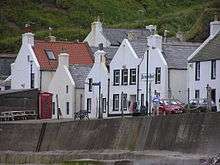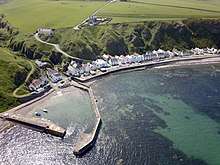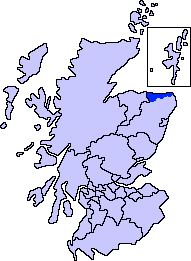Pennan
Pennan
| |
|---|---|
|
Pennan | |
 Pennan Pennan shown within Aberdeenshire | |
| OS grid reference | NJ845655 |
| Council area | |
| Lieutenancy area | |
| Country | Scotland |
| Sovereign state | United Kingdom |
| Post town | FRASERBURGH |
| Postcode district | AB43 |
| Dialling code | 01346 |
| Police | Scottish |
| Fire | Scottish |
| Ambulance | Scottish |
| EU Parliament | Scotland |
| UK Parliament | |
| Scottish Parliament | |
Pennan (Scots: Peenan)[1] is a small village in Aberdeenshire, Scotland[2] consisting of a small harbour and a single row of homes, including a hotel. It is on the north-facing coast and is about one hour's drive from Aberdeen.
Area history


Pennan seems to have come into existence as a fishing village in the 18th century. Until the 1930s, the population of the village seems to have come under three main surnames - Watt, Gatt and West. The people of Pennan were dependent on the sea. Most families had small boats for their own personal use. Where the men would catch the fish, it was usually down to the women and children to try to sell it to clients in the country. In the last 50 years, most of the native families have moved out and most of the houses have been bought as holiday homes. Pennan became famous in the 1980s for being used as one of the main locations for the film Local Hero, and representing the fictional village of Ferness. Film enthusiasts have come from all over the world to make a phone call in the red telephone box which featured in the film. The phone box was in fact originally put there only as a prop for the film, and then removed, but as a result of public demand a genuine telephone box was installed a few metres from the original spot (+44 (0)1346 6210), and has been a listed building since 1989.[3] Landslips, especially one in 2007, have been damaging the village.[4] In 2009 a 25-foot crack appeared on the cliff side, sparking calls for the village to be evacuated.
This part of Aberdeenshire was inhabited by prehistoric peoples since at least the Bronze Age. One of the most ancient extant monuments is the long barrow at Longman Hill.[5]
Footnotes
- ↑ The Online Scots Dictionary
- ↑ UK Ordnance Survey, 2004
- ↑ Historic Scotland: Aberdeenshire listed building report
- ↑ http://news.bbc.co.uk/2/hi/uk_news/scotland/north_east/8365494.stm
- ↑ C.M.Hogan, 2008
References
External links
| Wikimedia Commons has media related to Pennan. |
- Pennan Tourism Tourist attractions in Pennan
- Panorama of Pennan Harbour (QuickTime required)
- Parish churches Website for Aberdour and Pennan churches
- The Pennan Inn The famous hotel in Pennan

